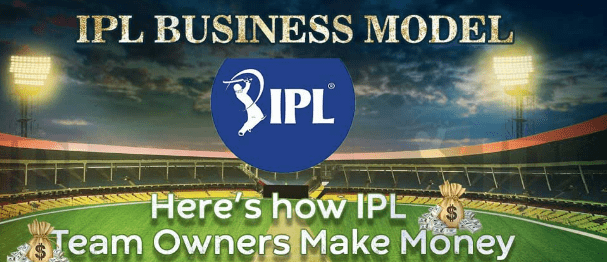Let’s find out how the IPL generates revenue and compare the IPL business model to other leagues such as the EPL and NFL.
Over the years, IPL has become very popular and changed how people see cricket worldwide. It brings about a new level of excitement every year, and fans can’t get enough of it.
OverView
Last week, the Indian Premier League (IPL) secured a broadcasting rights deal for the upcoming five seasons from 2023 to 2027. The deal was worth an enormous ₹48,390.5 crore ($6.2 billion) and according to ESPN Cricinfo, this amount is double the price paid for the previous five seasons (2018-22).
The Indian Premier League (IPL) is not just about the exciting on-field performances, but it also has an intriguing business model. The league primarily emphasizes on marketing strategies and uniting players from various countries to lure new fans and generate more revenue from advertising.
Stats of IPL in 2024

Viacom-18, which is backed by Mukesh Ambani, secured the digital broadcasting rights for ₹23,758 crore. This replaced the previous holder, Disney Star, which managed to retain the television rights for ₹23,575 crore. The rights to air IPL matches globally were split between Viacom and Times Internet, for a total of ₹1,075 crore. Additionally, Viacom paid ₹2,991 crore for a separate category of non-exclusive rights to air 18 critical matches each season.
Insights about IPL
| Particular | Details |
| Full Name | Indian Premier League (IPL) |
| Inaugural Season | 2008 |
| Number of Teams | 8 (as of my last update in September 2021) |
| Format | Twenty20 (T20) |
| Governing Body | Board of Control for Cricket in India (BCCI) |
| Founder | Lalit Modi |
| Most Successful Team | Mumbai Indians (5 IPL Championships) |
| Popular Teams | Mumbai Indians, CSK, Royal Challengers Bangalore (RCB), Kolkata Knight Riders, Gujrat Titans etc |
| Auction for Players | Initially, it was 4, increased to 5 in later seasons |
| Overseas Players Limit per Team | Initially it was 4, increased to 5 in later seasons |
| Venue for Finals | Mostly at Mumbai, Bengaluru, Chennai or Kolkatta |
| TV Broadcast Partners | Various broadcasters, including Star Sports |
| Brand Value (As of 2021) | US$3.2 billion |
| Notable Players | Virat Kohli, MS Dhoni, Rohit Sharma, Rinku Singh and many international stars |

IPL Business Model
The IPL business model is based on a unique combination of cricket, entertainment, and marketing strategies. The league follows a franchise system where ten teams representing different cities in India compete against each other. The franchises operate on a revenue-sharing model. The league generates revenue from broadcasting rights, sponsorship deals, merchandise sales, player auctions, and endorsements.

The IPL Revenue Model
Since its launch in 2007, the IPL has captured the nation’s imagination with its watertight revenue model, which is a potent blend of:
1. Broadcast Rights:
This is the IPL’s golden goose. The 2024 media rights deal shattered records, fetching a staggering $16.8 million per match, dwarfing the likes of the NBA ($1.1 million) and Bundesliga ($4.6 million). Talk about leaving the competition in the dust!
2. Sponsorships:
From team jerseys to on-ground branding, sponsorships are another major earner. Big brands vie for a piece of the IPL pie, creating a win-win for franchises and the league.
Sponsorship deals play a significant role in generating revenue for IPL franchises. These teams enter into agreements with multiple brands, such as apparel companies, beverage manufacturers, and mobile phone brands. These deals provide a substantial amount of money to the franchises, which they can use to cover their expenses.
3. Central Pool of Revenue:
Here’s a twist. Unlike some leagues, the BCCI (Board of Control for Cricket in India) shares an approximately 50% portion of central revenue with all franchises. This ensures financial stability and a level playing field.
4. Gate Revenue:
Though the pandemic threw a curveball, ticket sales are a crucial revenue stream. Packed stadiums create a vibrant atmosphere and contribute significantly to the IPL’s coffers.
5. Merchandise Sales:
From jerseys to team merchandise, fans proudly sport their favorite franchise’s colors. This not only fuels passion but also brings in handsome profits. IPL franchises generate revenue from merchandise sales. They sell team jerseys, hats, and other accessories, which contribute to their earnings. The popularity of the IPL has resulted in a significant demand for merchandise, and the franchises are profiting from it.
6. Digital Rights:
With the advent of OTT platforms and digital viewership, the IPL has expanded its revenue horizons beyond traditional broadcast. Streaming rights are a hot commodity, with platforms eager to host the cricket carnival.
7. Player Auctions
Player auctions are an integral part of the IPL and also generate significant revenue for franchises. Every year, teams participate in auctions to acquire players.
The team owners bid for the players they want to include in their team. The price of the players depends on their performance and popularity. The team owners can make a profit by selling the players they bought at a higher price than they paid.
Watch: IPL Business Model
Final Words
The Indian Premier League (IPL) is one of the most popular sports leagues in the world, overshadowing even well-established leagues such as the English Premier League (EPL), La Liga, and the NBA. It began in 2008 as an ambitious project but has now become a massive phenomenon, revolutionizing the world of cricket and sports economics.
The IPL’s brand value is an impressive $10.7 billion as of 2024, which is a testament to its massive impact. However, behind all the glamour and glitz lies a robust business model that has turned the league into a significant capitalistic marvel for India’s economy.






